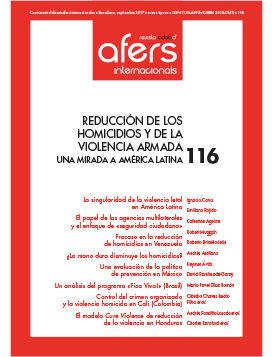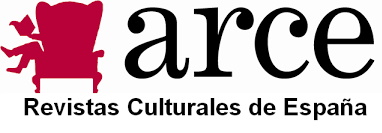Do heavy-handed tactics reduce homicides? The case of Venezuela
Keywords:
police violence, homicides, criminal policy, institutional violence, VenezuelaAbstract
Revista CIDOB d’Afers Internacionals, nº 116
Quadrimestral (May-September 2017)
ISSN:1133-6595 | E-ISSN:2013-035X
DOI: https://doi.org/10.24241/rcai.2017.116.2.77
This article examines the effectiveness of mano dura (heavy-handed) policies in reducing homicides by studying the case of Venezuela in the period 2012-2015 and gives particular attention to policies involving police violence. Although firm hand policies involve a set of strategies and discourses that revolve around the crime and the institutional response to it, this paper exclusively addresses police interventions that involve increased coercion and violence as a formula for tackling criminality. Over these years, policies have been tested out in Venezuela that involve greater police violence on the pretext of defeating the high levels of criminal violence. But rather than the expected effects of reducing violence and homicides, both have grown significantly.
>> The full text articles of this issue are available only in Spanish language
References
Antillano, Andrés. «¿Qué conocemos de la violencia policial en Venezuela? Las investigaciones e hipótesis sobre el uso de la fuerza física por la policía». Espacio Abierto, vol. 19, n.º 2 (abril-junio de 2010), p. 331-345 (en línea) [Fecha de consulta: 01.12.2016] http://redalyc.uaemex.mx/redalyc/pdf/122/12215086006.pdf
Antillano, Andrés. «La reforma policial en la Venezuela bolivariana», en: Zavaleta, José (coord.). El laberinto de la inseguridad ciudadana: bandas criminales, seguridad de fronteras y regímenes penitenciarios en América Latina. Buenos Aires: CLACSO, 2014, p. 63-92.
Antillano, Andrés. «Incluir y castigar: tensiones y paradojas de las políticas hacia los pobres en la Venezuela pos-neoliberal», en: Tavares, José y Barreira, César (orgs.). Paradoxos da segurança cidadã. Porto Alegre: Tomo Editorial, 2016, p.123-139.
Ávila, Keymer. «Funcionarios de cuerpos de seguridad víctimas de homicidio: Estudios de casos del Área Metropolitana de Caracas». Desafíos, vol. 28, n.º 2 (2016), p. 17-64.
Chacón, Andrea y Fernández-Shaw, José L. «La violencia no es inevitable». Revista SIC, n.º 758 (2013), p. 344-347.
Cruz, José M. «State and Criminal Violence in Latin American». Cimen, Law and Social Change, vol. 66, n.º 4 (2016), p. 375-396.
De Giorgi, Alessandro. Tolerancia cero. Estrategias y prácticas de la sociedad de control. Barcelona: Virus editorial, 2005.
Fondevilla, Gustavo y Meneses, Rodrigo. «The Problems and Promises of Research on Deaths Due to Legal Intervention in Latin America». Homicide Studies, vol. 19, n.º 4 (2014), p. 370-383.
Foucault, Michel. Saber y poder. Madrid: La Piqueta, 1984.
Gabaldón, Luis Gerardo y Serrano, Carla. Violencia urbana: perspectivas de jóvenes transgresores y funcionarios policiales en Venezuela. Caracas: Universidad Católica Andrés Bello, 2011.
Garland, David. La cultura del control. Crimen y orden social en la sociedad contemporánea. Barcelona: Gedisa, 2005.
Goffman, Alice. «On the Run. Wanted Men in a Philadelphia Ghetto». American Sociological Review, vol. 74, n.º 3 (2009), p. 339-357.
Grupo de Investigaciones Criminológicas (GIC). Estudio de Delitos Violentos Eje Centro Norte Costero de Venezuela (EDVECNCV, 2015). GIC, Universidad de los Andes, 2016.
Guerrero, Eduardo. «La raíz de la violencia». Nexos, (junio de 2011), (en línea) [Fecha de consulta: 01.12.2016] http://www.nexos.com.mx/?p=14318
Hall, Stuart; Critcher, Chas; Jefferson, Tony; Clarke, John y Roberts, Brian. Policing the crisis: mugging, the state, and law and order. Nueva York: Holmes and Meier Publishers, Inc., 1978.
Hernández, Tosca. «Los operativos “extraordinarios” en Venezuela: dos acercamientos reflexivos al problema». Capítulo Criminológico, vol. 14, (1986), p.1-25.
Holland, Alisha C. «Right on Crime? The Spatial Politics of Crime in El Salvador». APSA 2010 Annual Meeting Paper (en línea) [Fecha de consulta:01.12.2016] https://ssrn.com/abstract=1643152
Iturralde, Manuel. Castigo, liberalismo autoritario y justicia de excepción. Bogotá: Siglo del Hombre, 2010.
Kraska, Peter B. y Kappeler, Victor E. «Militarizing American Police: The Rise and Normalization of Paramilitary Units». Social Problems, vol. 44, n.º 1 (febrero de 1997), p. 1-18.
Kronick, Dorothy. «Cómo contar nuestros muertos». Prodavinci (julio de 2016) [Fecha de consulta: 01.12.2016] http://prodavinci.com/2016/07/01/actualidad/como-contar-nuestros-muertos-por-dorothy-kronick/
Lessing, Benjamin. «The Dangers of Dungeons: Prison Gangs and Incarcerated Militant Groups», en: VV.AA. Small Arms Survey 2010: Gangs, Groups and Guns. Cambridge: Cambridge University Press, 2010.
Merino, José. «Los operativos conjuntos y la tasa de homicidios. Una medición», Nexos (junio de 2011), (en línea) [Fecha de consulta: 01.12.2016] http://www.nexos.com.mx/?p=14319
Ministerio del Poder Popular para las Relaciones Interiores, Justicia y Paz. Plan Patria Segura. Mimeo, 2015.
Ministerio Público. Principales Estadísticas de Homicidios y tasas x 100.000 Habitantes, según entidad federal. Venezuela, 2012.
Ministerio Público. Principales Estadísticas de Homicidios y tasas x 100.000 Habitantes, según entidad federal. Venezuela, 2013.
Ministerio Público. Principales Estadísticas de Homicidios y tasas x 100.000 Habitantes, según entidad federal. Venezuela, 2014.
Ministerio Público. Informe Anual de Gestión 2015. Caracas, 2016.
Ministerio Público. Informe Anual de Gestión 2016. Caracas, 2017.
Observatorio Venezolano de Violencia «Informe Anual 2016». Observatorio Venezolano de Violencia (diciembre de 2016) (en línea) [Fecha de consulta: 23.04.2017] http://observatoriodeviolencia.org.ve/2016-ovv-estima28-479-muertes-violentas-en-venezuela/
Reiner, Robert. A política da polícia. Sao Paulo: EDUSP, 2004.
Santos, Thamara. «Policía y democracia en Venezuela». Policía y sociedad democrática, n.º 3 (1998), p. 199-218.
Sota, Alejandra; Messmacher, Miguel. «Operativos y violencia». Nexos (diciembre de 2012) (en línea) [Fecha de consulta: 01.12.2016] http://www.nexos.com.mx/?p=15087
Sozzo, Máximo (comp.). Postneoliberalismo y penalidad en América del Sur. Buenos Aires: CLACSO, 2016.
Sykes, Gresham y Matza, David. «Techniques of Neutralization: A Theory of Delinquency», en: American Sociological Review, vol. 22, n.º 6 (1957), p. 664-670.
Wacquant, Loïc. Las Cárceles de la Miseria. Buenos Aires: Manantial, 2000.
Wacquant, Loïc. «Toward a dictatorship over the poor? Notes on the penalization of poverty in Brazil». Punishment & Society, vol. 5, n.º 2 (2003), p. 197-205.
Wacquant, Loïc. Castigar a los pobres. El gobierno neoliberal de la inseguridad social. Barcelona: Editorial Gedisa, 2010.
Wolf, Sonja. «Mano Dura: Gang Supression in The Salvador». Sustainable Security (marzo de 2011) (en línea) [Fecha de consulta: 01.12.2016] https:// sustainablesecurity.org/2011/03/01/mano-dura-gang-suppression-in-el-salvador/












